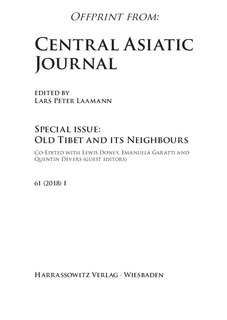| dc.contributor.author | Doney, Lewis | |
| dc.date.accessioned | 2019-05-07T07:09:52Z | |
| dc.date.available | 2019-05-07T07:09:52Z | |
| dc.date.created | 2018-12-17T17:39:00Z | |
| dc.date.issued | 2018 | |
| dc.identifier.citation | Central Asiatic journal. 2018, 61 (1), 71-101. | nb_NO |
| dc.identifier.issn | 0008-9192 | |
| dc.identifier.uri | http://hdl.handle.net/11250/2596696 | |
| dc.description.abstract | This article offers some more detail on a Tibetan prayer dating from the ninth century and recently discovered in Mogao Cave 17. This Tridaṇḍaka prayer was perhaps first written, translated or compiled in the the late Tibetan imperial period (circa 600–842). Some phrases in the prayer correspond to the bSam yas Bell Inscription written during the eighth century, and others point towards similarities between this prayer and the Sarvadurgatipariśodhana tantra and closely connected Uṣṇīṣavijaya dhāraṇī sūtra. Analysing the content of this prayer helps to assess early Tibetan Buddhist praise literature and its connections with contemporaneous Indic and Chinese Buddhism. It also links Tibetan imperial literature to later Tibetan Buddhist historiography in Tibet. | nb_NO |
| dc.language.iso | eng | nb_NO |
| dc.publisher | Harrassowitz Verlag | nb_NO |
| dc.title | Imperial Gods: A Ninth-Century Tridaṇḍaka Prayer (rGyud chags gsum) from Dunhuang | nb_NO |
| dc.type | Journal article | nb_NO |
| dc.type | Peer reviewed | nb_NO |
| dc.description.version | publishedVersion | nb_NO |
| dc.source.pagenumber | 71-101 | nb_NO |
| dc.source.volume | 61 | nb_NO |
| dc.source.journal | Central Asiatic journal | nb_NO |
| dc.source.issue | 1 | nb_NO |
| dc.identifier.doi | 10.13173/centasiaj.61.1.0071 | |
| dc.identifier.cristin | 1644506 | |
| dc.description.localcode | Locked until 30.6.2020 due to copyright restrictions. | nb_NO |
| cristin.unitcode | 194,62,70,0 | |
| cristin.unitname | Institutt for filosofi og religionsvitenskap | |
| cristin.ispublished | true | |
| cristin.fulltext | original | |
| cristin.qualitycode | 1 | |
